Application of McLuhan’s Laws of Media to Australian Emission Control
VerifiedAdded on 2020/04/13
|9
|2277
|44
Report
AI Summary
This report examines the challenges and opportunities Australia faces in reducing greenhouse gas emissions, with a focus on achieving an 80% reduction by 2050. It identifies wind energy as a key sustainable resource and analyzes the existing technological limitations, such as the weight and cost of wind turbines. The report proposes a solution developed by researchers at the University of Wollongong in New South Wales: a magnesium diboride superconducting coil to replace traditional gearboxes, reducing weight and cost. The study then applies McLuhan's Laws of Media to evaluate the viability and impact of this new technology, assessing its potential to enhance wind energy conversion, displace existing technologies, recover the usefulness of wind, and support large-scale energy production. The report concludes that the proposed technology holds significant promise for Australia's sustainable energy goals and its efforts to reduce greenhouse gas emissions, emphasizing the importance of investment in renewable energy solutions.
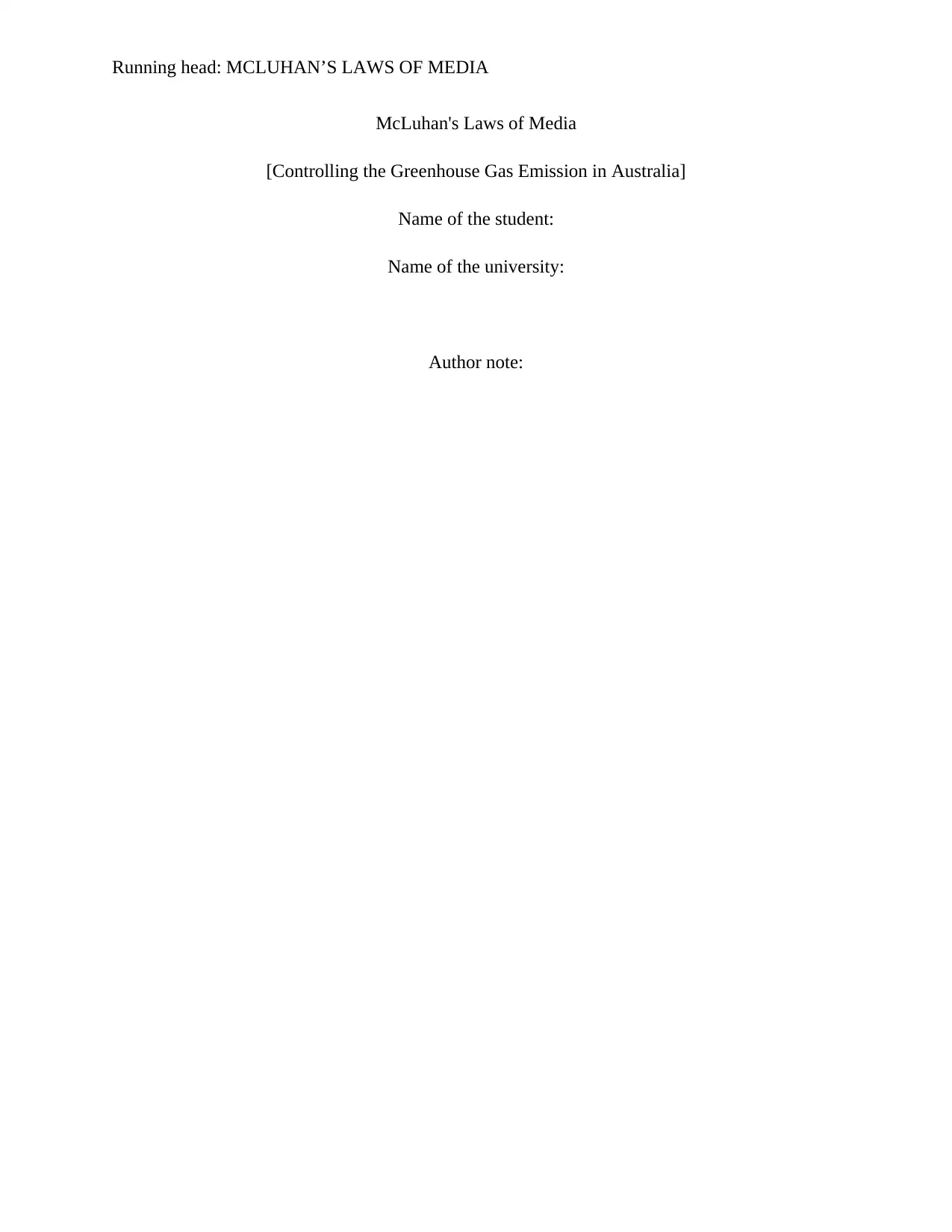
Running head: MCLUHAN’S LAWS OF MEDIA
McLuhan's Laws of Media
[Controlling the Greenhouse Gas Emission in Australia]
Name of the student:
Name of the university:
Author note:
McLuhan's Laws of Media
[Controlling the Greenhouse Gas Emission in Australia]
Name of the student:
Name of the university:
Author note:
Paraphrase This Document
Need a fresh take? Get an instant paraphrase of this document with our AI Paraphraser
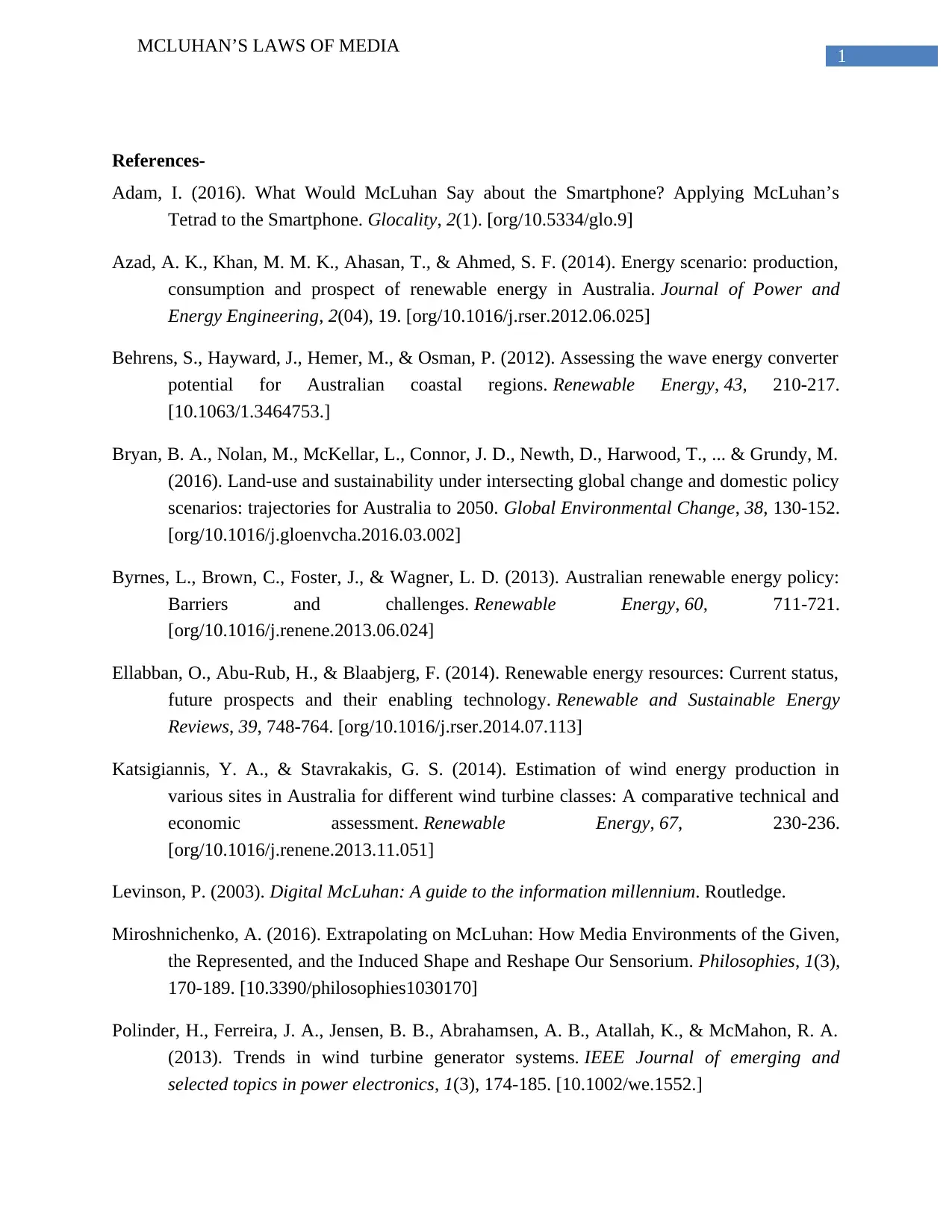
1
MCLUHAN’S LAWS OF MEDIA
References-
Adam, I. (2016). What Would McLuhan Say about the Smartphone? Applying McLuhan’s
Tetrad to the Smartphone. Glocality, 2(1). [org/10.5334/glo.9]
Azad, A. K., Khan, M. M. K., Ahasan, T., & Ahmed, S. F. (2014). Energy scenario: production,
consumption and prospect of renewable energy in Australia. Journal of Power and
Energy Engineering, 2(04), 19. [org/10.1016/j.rser.2012.06.025]
Behrens, S., Hayward, J., Hemer, M., & Osman, P. (2012). Assessing the wave energy converter
potential for Australian coastal regions. Renewable Energy, 43, 210-217.
[10.1063/1.3464753.]
Bryan, B. A., Nolan, M., McKellar, L., Connor, J. D., Newth, D., Harwood, T., ... & Grundy, M.
(2016). Land-use and sustainability under intersecting global change and domestic policy
scenarios: trajectories for Australia to 2050. Global Environmental Change, 38, 130-152.
[org/10.1016/j.gloenvcha.2016.03.002]
Byrnes, L., Brown, C., Foster, J., & Wagner, L. D. (2013). Australian renewable energy policy:
Barriers and challenges. Renewable Energy, 60, 711-721.
[org/10.1016/j.renene.2013.06.024]
Ellabban, O., Abu-Rub, H., & Blaabjerg, F. (2014). Renewable energy resources: Current status,
future prospects and their enabling technology. Renewable and Sustainable Energy
Reviews, 39, 748-764. [org/10.1016/j.rser.2014.07.113]
Katsigiannis, Y. A., & Stavrakakis, G. S. (2014). Estimation of wind energy production in
various sites in Australia for different wind turbine classes: A comparative technical and
economic assessment. Renewable Energy, 67, 230-236.
[org/10.1016/j.renene.2013.11.051]
Levinson, P. (2003). Digital McLuhan: A guide to the information millennium. Routledge.
Miroshnichenko, A. (2016). Extrapolating on McLuhan: How Media Environments of the Given,
the Represented, and the Induced Shape and Reshape Our Sensorium. Philosophies, 1(3),
170-189. [10.3390/philosophies1030170]
Polinder, H., Ferreira, J. A., Jensen, B. B., Abrahamsen, A. B., Atallah, K., & McMahon, R. A.
(2013). Trends in wind turbine generator systems. IEEE Journal of emerging and
selected topics in power electronics, 1(3), 174-185. [10.1002/we.1552.]
MCLUHAN’S LAWS OF MEDIA
References-
Adam, I. (2016). What Would McLuhan Say about the Smartphone? Applying McLuhan’s
Tetrad to the Smartphone. Glocality, 2(1). [org/10.5334/glo.9]
Azad, A. K., Khan, M. M. K., Ahasan, T., & Ahmed, S. F. (2014). Energy scenario: production,
consumption and prospect of renewable energy in Australia. Journal of Power and
Energy Engineering, 2(04), 19. [org/10.1016/j.rser.2012.06.025]
Behrens, S., Hayward, J., Hemer, M., & Osman, P. (2012). Assessing the wave energy converter
potential for Australian coastal regions. Renewable Energy, 43, 210-217.
[10.1063/1.3464753.]
Bryan, B. A., Nolan, M., McKellar, L., Connor, J. D., Newth, D., Harwood, T., ... & Grundy, M.
(2016). Land-use and sustainability under intersecting global change and domestic policy
scenarios: trajectories for Australia to 2050. Global Environmental Change, 38, 130-152.
[org/10.1016/j.gloenvcha.2016.03.002]
Byrnes, L., Brown, C., Foster, J., & Wagner, L. D. (2013). Australian renewable energy policy:
Barriers and challenges. Renewable Energy, 60, 711-721.
[org/10.1016/j.renene.2013.06.024]
Ellabban, O., Abu-Rub, H., & Blaabjerg, F. (2014). Renewable energy resources: Current status,
future prospects and their enabling technology. Renewable and Sustainable Energy
Reviews, 39, 748-764. [org/10.1016/j.rser.2014.07.113]
Katsigiannis, Y. A., & Stavrakakis, G. S. (2014). Estimation of wind energy production in
various sites in Australia for different wind turbine classes: A comparative technical and
economic assessment. Renewable Energy, 67, 230-236.
[org/10.1016/j.renene.2013.11.051]
Levinson, P. (2003). Digital McLuhan: A guide to the information millennium. Routledge.
Miroshnichenko, A. (2016). Extrapolating on McLuhan: How Media Environments of the Given,
the Represented, and the Induced Shape and Reshape Our Sensorium. Philosophies, 1(3),
170-189. [10.3390/philosophies1030170]
Polinder, H., Ferreira, J. A., Jensen, B. B., Abrahamsen, A. B., Atallah, K., & McMahon, R. A.
(2013). Trends in wind turbine generator systems. IEEE Journal of emerging and
selected topics in power electronics, 1(3), 174-185. [10.1002/we.1552.]
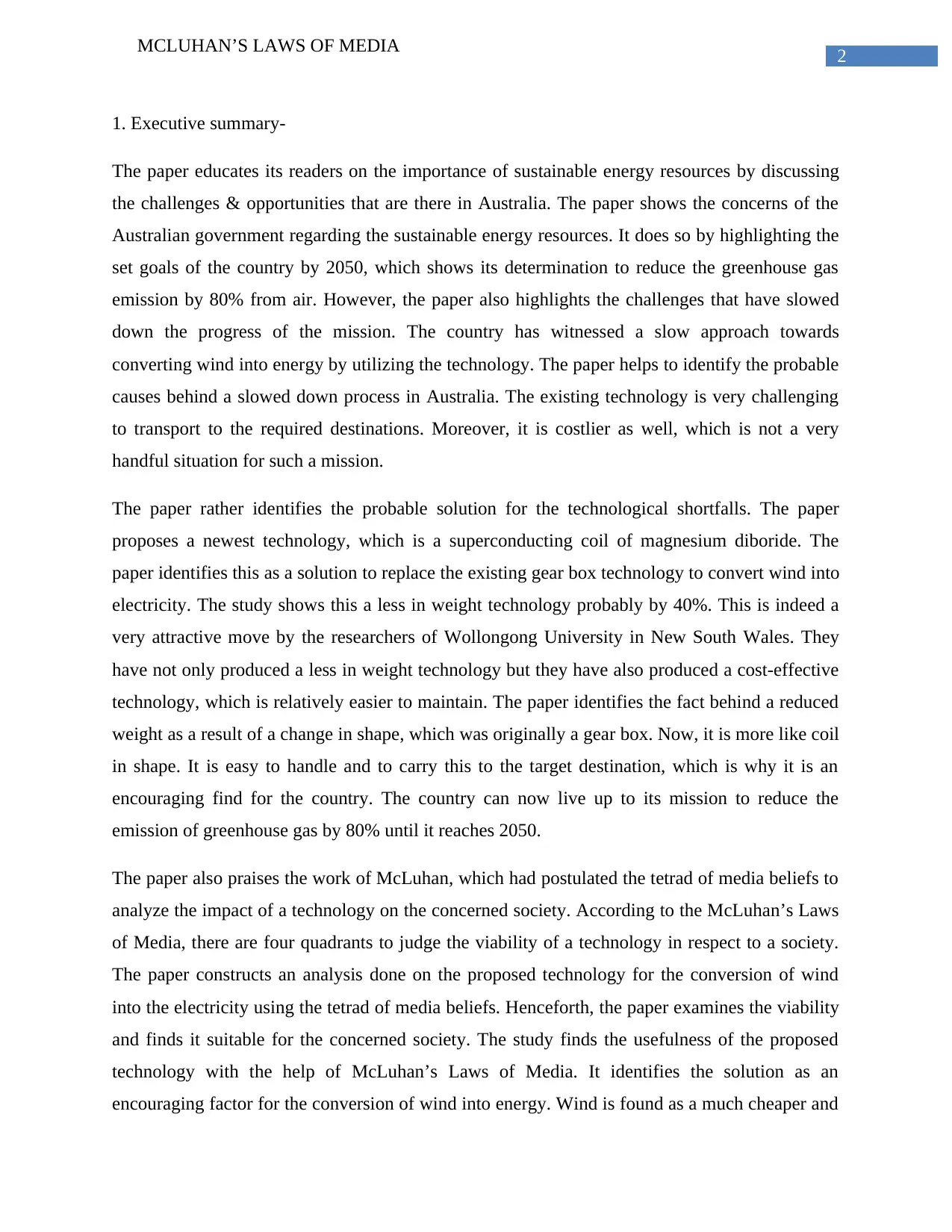
2
MCLUHAN’S LAWS OF MEDIA
1. Executive summary-
The paper educates its readers on the importance of sustainable energy resources by discussing
the challenges & opportunities that are there in Australia. The paper shows the concerns of the
Australian government regarding the sustainable energy resources. It does so by highlighting the
set goals of the country by 2050, which shows its determination to reduce the greenhouse gas
emission by 80% from air. However, the paper also highlights the challenges that have slowed
down the progress of the mission. The country has witnessed a slow approach towards
converting wind into energy by utilizing the technology. The paper helps to identify the probable
causes behind a slowed down process in Australia. The existing technology is very challenging
to transport to the required destinations. Moreover, it is costlier as well, which is not a very
handful situation for such a mission.
The paper rather identifies the probable solution for the technological shortfalls. The paper
proposes a newest technology, which is a superconducting coil of magnesium diboride. The
paper identifies this as a solution to replace the existing gear box technology to convert wind into
electricity. The study shows this a less in weight technology probably by 40%. This is indeed a
very attractive move by the researchers of Wollongong University in New South Wales. They
have not only produced a less in weight technology but they have also produced a cost-effective
technology, which is relatively easier to maintain. The paper identifies the fact behind a reduced
weight as a result of a change in shape, which was originally a gear box. Now, it is more like coil
in shape. It is easy to handle and to carry this to the target destination, which is why it is an
encouraging find for the country. The country can now live up to its mission to reduce the
emission of greenhouse gas by 80% until it reaches 2050.
The paper also praises the work of McLuhan, which had postulated the tetrad of media beliefs to
analyze the impact of a technology on the concerned society. According to the McLuhan’s Laws
of Media, there are four quadrants to judge the viability of a technology in respect to a society.
The paper constructs an analysis done on the proposed technology for the conversion of wind
into the electricity using the tetrad of media beliefs. Henceforth, the paper examines the viability
and finds it suitable for the concerned society. The study finds the usefulness of the proposed
technology with the help of McLuhan’s Laws of Media. It identifies the solution as an
encouraging factor for the conversion of wind into energy. Wind is found as a much cheaper and
MCLUHAN’S LAWS OF MEDIA
1. Executive summary-
The paper educates its readers on the importance of sustainable energy resources by discussing
the challenges & opportunities that are there in Australia. The paper shows the concerns of the
Australian government regarding the sustainable energy resources. It does so by highlighting the
set goals of the country by 2050, which shows its determination to reduce the greenhouse gas
emission by 80% from air. However, the paper also highlights the challenges that have slowed
down the progress of the mission. The country has witnessed a slow approach towards
converting wind into energy by utilizing the technology. The paper helps to identify the probable
causes behind a slowed down process in Australia. The existing technology is very challenging
to transport to the required destinations. Moreover, it is costlier as well, which is not a very
handful situation for such a mission.
The paper rather identifies the probable solution for the technological shortfalls. The paper
proposes a newest technology, which is a superconducting coil of magnesium diboride. The
paper identifies this as a solution to replace the existing gear box technology to convert wind into
electricity. The study shows this a less in weight technology probably by 40%. This is indeed a
very attractive move by the researchers of Wollongong University in New South Wales. They
have not only produced a less in weight technology but they have also produced a cost-effective
technology, which is relatively easier to maintain. The paper identifies the fact behind a reduced
weight as a result of a change in shape, which was originally a gear box. Now, it is more like coil
in shape. It is easy to handle and to carry this to the target destination, which is why it is an
encouraging find for the country. The country can now live up to its mission to reduce the
emission of greenhouse gas by 80% until it reaches 2050.
The paper also praises the work of McLuhan, which had postulated the tetrad of media beliefs to
analyze the impact of a technology on the concerned society. According to the McLuhan’s Laws
of Media, there are four quadrants to judge the viability of a technology in respect to a society.
The paper constructs an analysis done on the proposed technology for the conversion of wind
into the electricity using the tetrad of media beliefs. Henceforth, the paper examines the viability
and finds it suitable for the concerned society. The study finds the usefulness of the proposed
technology with the help of McLuhan’s Laws of Media. It identifies the solution as an
encouraging factor for the conversion of wind into energy. Wind is found as a much cheaper and
⊘ This is a preview!⊘
Do you want full access?
Subscribe today to unlock all pages.

Trusted by 1+ million students worldwide

3
MCLUHAN’S LAWS OF MEDIA
cleaner option for the generation of electricity. Moreover, it finds wind as a better way to
generate more renewable energy and to provide a sustainable energy resource to Australia. This
is indeed required to reduce the emission of greenhouse gases, which has become a widely
spread concern for the entire world.
MCLUHAN’S LAWS OF MEDIA
cleaner option for the generation of electricity. Moreover, it finds wind as a better way to
generate more renewable energy and to provide a sustainable energy resource to Australia. This
is indeed required to reduce the emission of greenhouse gases, which has become a widely
spread concern for the entire world.
Paraphrase This Document
Need a fresh take? Get an instant paraphrase of this document with our AI Paraphraser
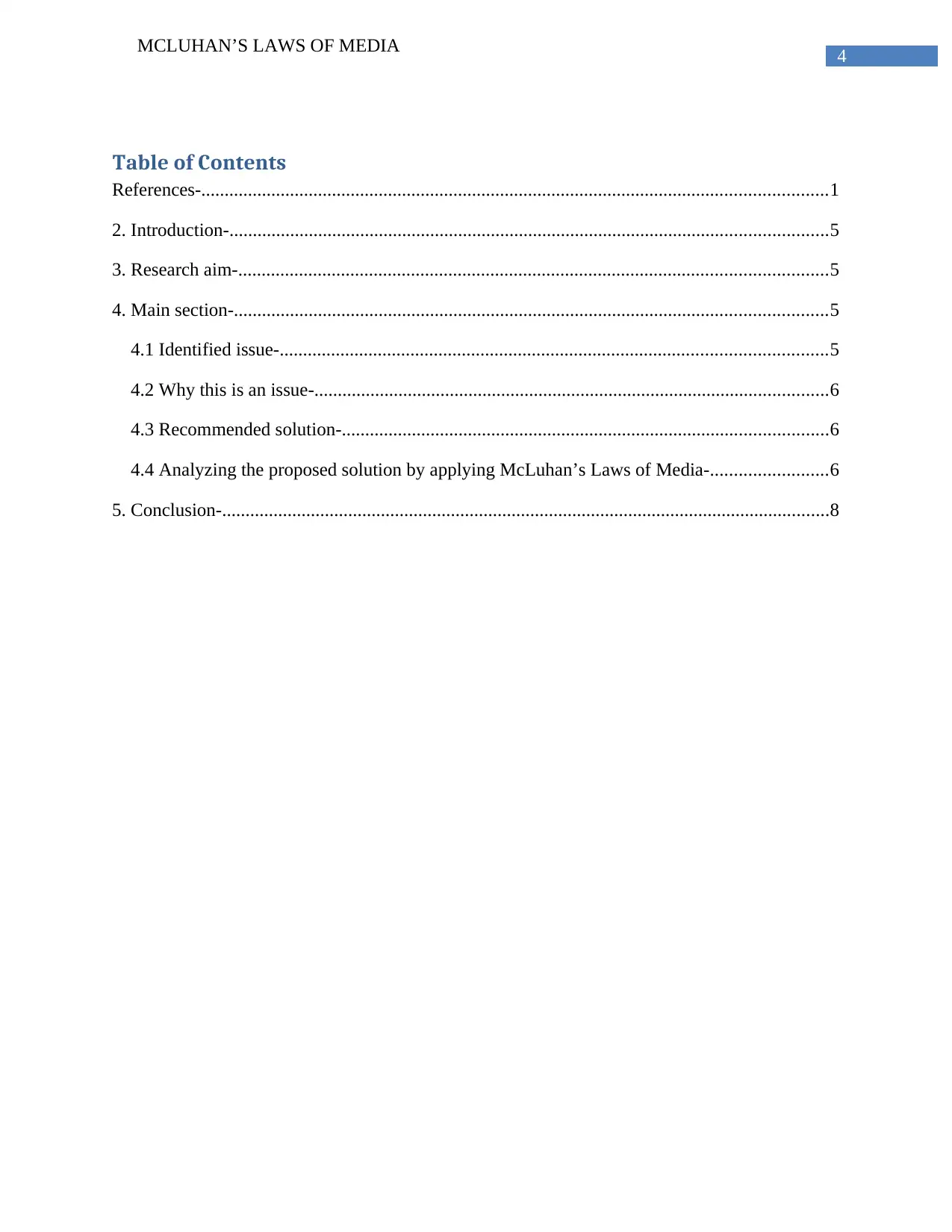
4
MCLUHAN’S LAWS OF MEDIA
Table of Contents
References-......................................................................................................................................1
2. Introduction-................................................................................................................................5
3. Research aim-..............................................................................................................................5
4. Main section-...............................................................................................................................5
4.1 Identified issue-.....................................................................................................................5
4.2 Why this is an issue-..............................................................................................................6
4.3 Recommended solution-........................................................................................................6
4.4 Analyzing the proposed solution by applying McLuhan’s Laws of Media-.........................6
5. Conclusion-..................................................................................................................................8
MCLUHAN’S LAWS OF MEDIA
Table of Contents
References-......................................................................................................................................1
2. Introduction-................................................................................................................................5
3. Research aim-..............................................................................................................................5
4. Main section-...............................................................................................................................5
4.1 Identified issue-.....................................................................................................................5
4.2 Why this is an issue-..............................................................................................................6
4.3 Recommended solution-........................................................................................................6
4.4 Analyzing the proposed solution by applying McLuhan’s Laws of Media-.........................6
5. Conclusion-..................................................................................................................................8
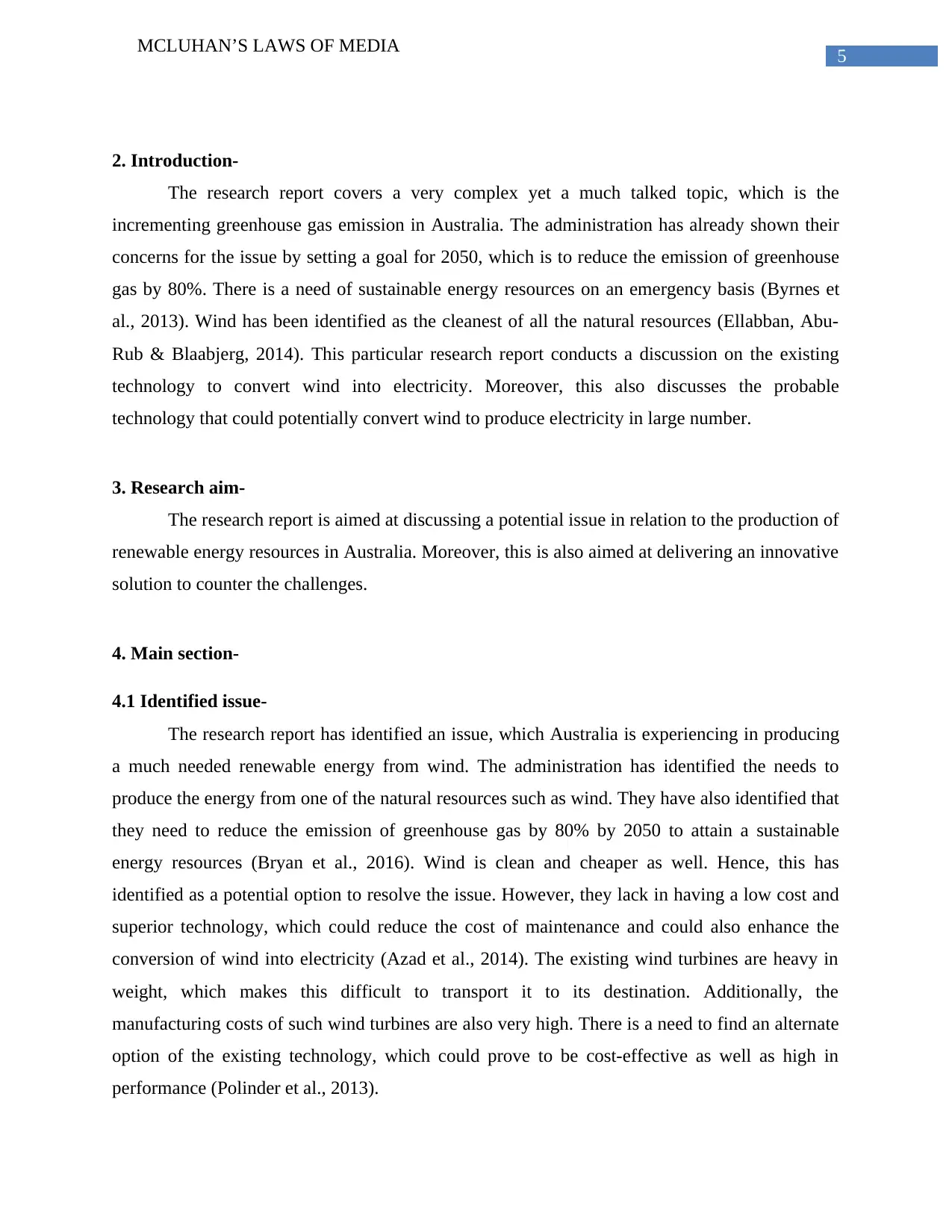
5
MCLUHAN’S LAWS OF MEDIA
2. Introduction-
The research report covers a very complex yet a much talked topic, which is the
incrementing greenhouse gas emission in Australia. The administration has already shown their
concerns for the issue by setting a goal for 2050, which is to reduce the emission of greenhouse
gas by 80%. There is a need of sustainable energy resources on an emergency basis (Byrnes et
al., 2013). Wind has been identified as the cleanest of all the natural resources (Ellabban, Abu-
Rub & Blaabjerg, 2014). This particular research report conducts a discussion on the existing
technology to convert wind into electricity. Moreover, this also discusses the probable
technology that could potentially convert wind to produce electricity in large number.
3. Research aim-
The research report is aimed at discussing a potential issue in relation to the production of
renewable energy resources in Australia. Moreover, this is also aimed at delivering an innovative
solution to counter the challenges.
4. Main section-
4.1 Identified issue-
The research report has identified an issue, which Australia is experiencing in producing
a much needed renewable energy from wind. The administration has identified the needs to
produce the energy from one of the natural resources such as wind. They have also identified that
they need to reduce the emission of greenhouse gas by 80% by 2050 to attain a sustainable
energy resources (Bryan et al., 2016). Wind is clean and cheaper as well. Hence, this has
identified as a potential option to resolve the issue. However, they lack in having a low cost and
superior technology, which could reduce the cost of maintenance and could also enhance the
conversion of wind into electricity (Azad et al., 2014). The existing wind turbines are heavy in
weight, which makes this difficult to transport it to its destination. Additionally, the
manufacturing costs of such wind turbines are also very high. There is a need to find an alternate
option of the existing technology, which could prove to be cost-effective as well as high in
performance (Polinder et al., 2013).
MCLUHAN’S LAWS OF MEDIA
2. Introduction-
The research report covers a very complex yet a much talked topic, which is the
incrementing greenhouse gas emission in Australia. The administration has already shown their
concerns for the issue by setting a goal for 2050, which is to reduce the emission of greenhouse
gas by 80%. There is a need of sustainable energy resources on an emergency basis (Byrnes et
al., 2013). Wind has been identified as the cleanest of all the natural resources (Ellabban, Abu-
Rub & Blaabjerg, 2014). This particular research report conducts a discussion on the existing
technology to convert wind into electricity. Moreover, this also discusses the probable
technology that could potentially convert wind to produce electricity in large number.
3. Research aim-
The research report is aimed at discussing a potential issue in relation to the production of
renewable energy resources in Australia. Moreover, this is also aimed at delivering an innovative
solution to counter the challenges.
4. Main section-
4.1 Identified issue-
The research report has identified an issue, which Australia is experiencing in producing
a much needed renewable energy from wind. The administration has identified the needs to
produce the energy from one of the natural resources such as wind. They have also identified that
they need to reduce the emission of greenhouse gas by 80% by 2050 to attain a sustainable
energy resources (Bryan et al., 2016). Wind is clean and cheaper as well. Hence, this has
identified as a potential option to resolve the issue. However, they lack in having a low cost and
superior technology, which could reduce the cost of maintenance and could also enhance the
conversion of wind into electricity (Azad et al., 2014). The existing wind turbines are heavy in
weight, which makes this difficult to transport it to its destination. Additionally, the
manufacturing costs of such wind turbines are also very high. There is a need to find an alternate
option of the existing technology, which could prove to be cost-effective as well as high in
performance (Polinder et al., 2013).
⊘ This is a preview!⊘
Do you want full access?
Subscribe today to unlock all pages.

Trusted by 1+ million students worldwide
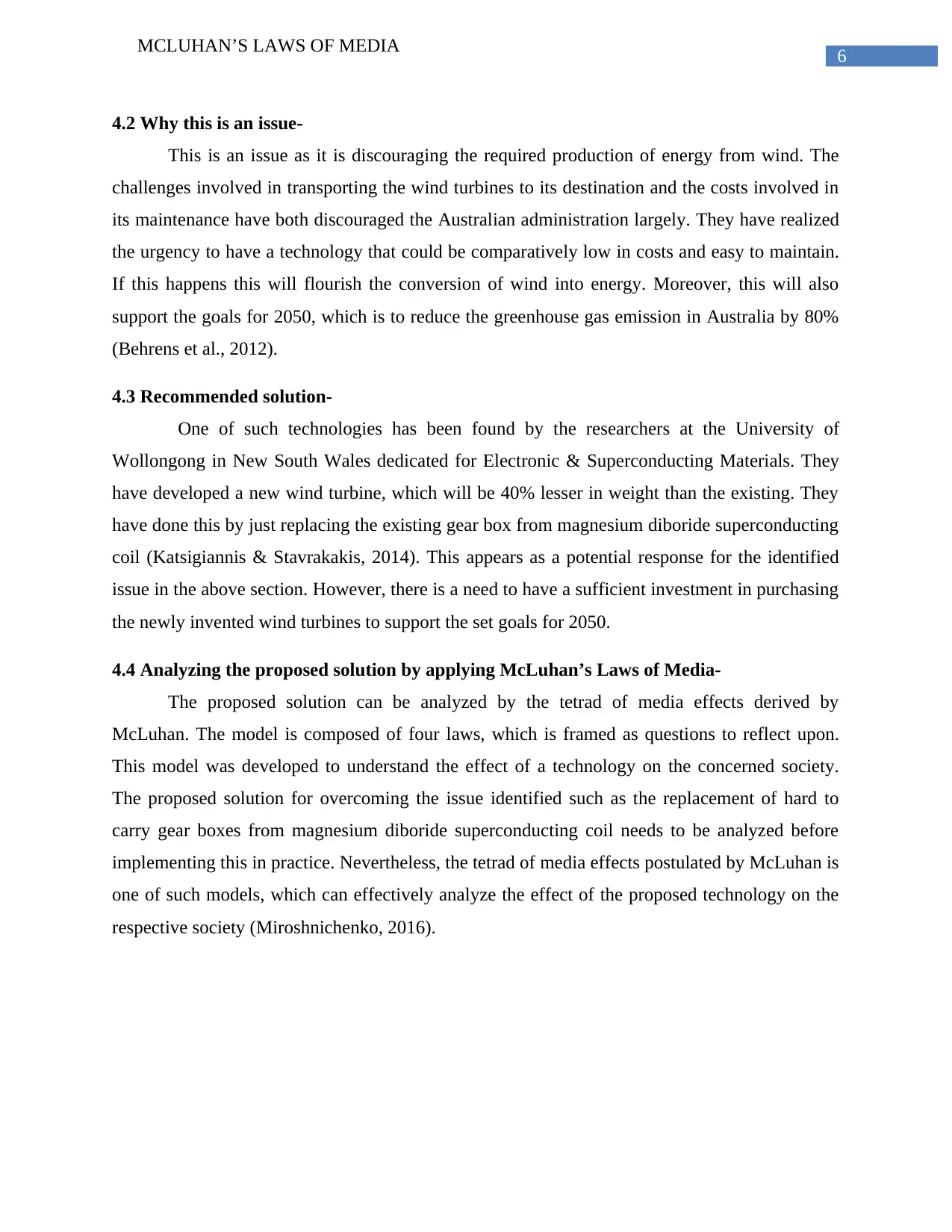
6
MCLUHAN’S LAWS OF MEDIA
4.2 Why this is an issue-
This is an issue as it is discouraging the required production of energy from wind. The
challenges involved in transporting the wind turbines to its destination and the costs involved in
its maintenance have both discouraged the Australian administration largely. They have realized
the urgency to have a technology that could be comparatively low in costs and easy to maintain.
If this happens this will flourish the conversion of wind into energy. Moreover, this will also
support the goals for 2050, which is to reduce the greenhouse gas emission in Australia by 80%
(Behrens et al., 2012).
4.3 Recommended solution-
One of such technologies has been found by the researchers at the University of
Wollongong in New South Wales dedicated for Electronic & Superconducting Materials. They
have developed a new wind turbine, which will be 40% lesser in weight than the existing. They
have done this by just replacing the existing gear box from magnesium diboride superconducting
coil (Katsigiannis & Stavrakakis, 2014). This appears as a potential response for the identified
issue in the above section. However, there is a need to have a sufficient investment in purchasing
the newly invented wind turbines to support the set goals for 2050.
4.4 Analyzing the proposed solution by applying McLuhan’s Laws of Media-
The proposed solution can be analyzed by the tetrad of media effects derived by
McLuhan. The model is composed of four laws, which is framed as questions to reflect upon.
This model was developed to understand the effect of a technology on the concerned society.
The proposed solution for overcoming the issue identified such as the replacement of hard to
carry gear boxes from magnesium diboride superconducting coil needs to be analyzed before
implementing this in practice. Nevertheless, the tetrad of media effects postulated by McLuhan is
one of such models, which can effectively analyze the effect of the proposed technology on the
respective society (Miroshnichenko, 2016).
MCLUHAN’S LAWS OF MEDIA
4.2 Why this is an issue-
This is an issue as it is discouraging the required production of energy from wind. The
challenges involved in transporting the wind turbines to its destination and the costs involved in
its maintenance have both discouraged the Australian administration largely. They have realized
the urgency to have a technology that could be comparatively low in costs and easy to maintain.
If this happens this will flourish the conversion of wind into energy. Moreover, this will also
support the goals for 2050, which is to reduce the greenhouse gas emission in Australia by 80%
(Behrens et al., 2012).
4.3 Recommended solution-
One of such technologies has been found by the researchers at the University of
Wollongong in New South Wales dedicated for Electronic & Superconducting Materials. They
have developed a new wind turbine, which will be 40% lesser in weight than the existing. They
have done this by just replacing the existing gear box from magnesium diboride superconducting
coil (Katsigiannis & Stavrakakis, 2014). This appears as a potential response for the identified
issue in the above section. However, there is a need to have a sufficient investment in purchasing
the newly invented wind turbines to support the set goals for 2050.
4.4 Analyzing the proposed solution by applying McLuhan’s Laws of Media-
The proposed solution can be analyzed by the tetrad of media effects derived by
McLuhan. The model is composed of four laws, which is framed as questions to reflect upon.
This model was developed to understand the effect of a technology on the concerned society.
The proposed solution for overcoming the issue identified such as the replacement of hard to
carry gear boxes from magnesium diboride superconducting coil needs to be analyzed before
implementing this in practice. Nevertheless, the tetrad of media effects postulated by McLuhan is
one of such models, which can effectively analyze the effect of the proposed technology on the
respective society (Miroshnichenko, 2016).
Paraphrase This Document
Need a fresh take? Get an instant paraphrase of this document with our AI Paraphraser
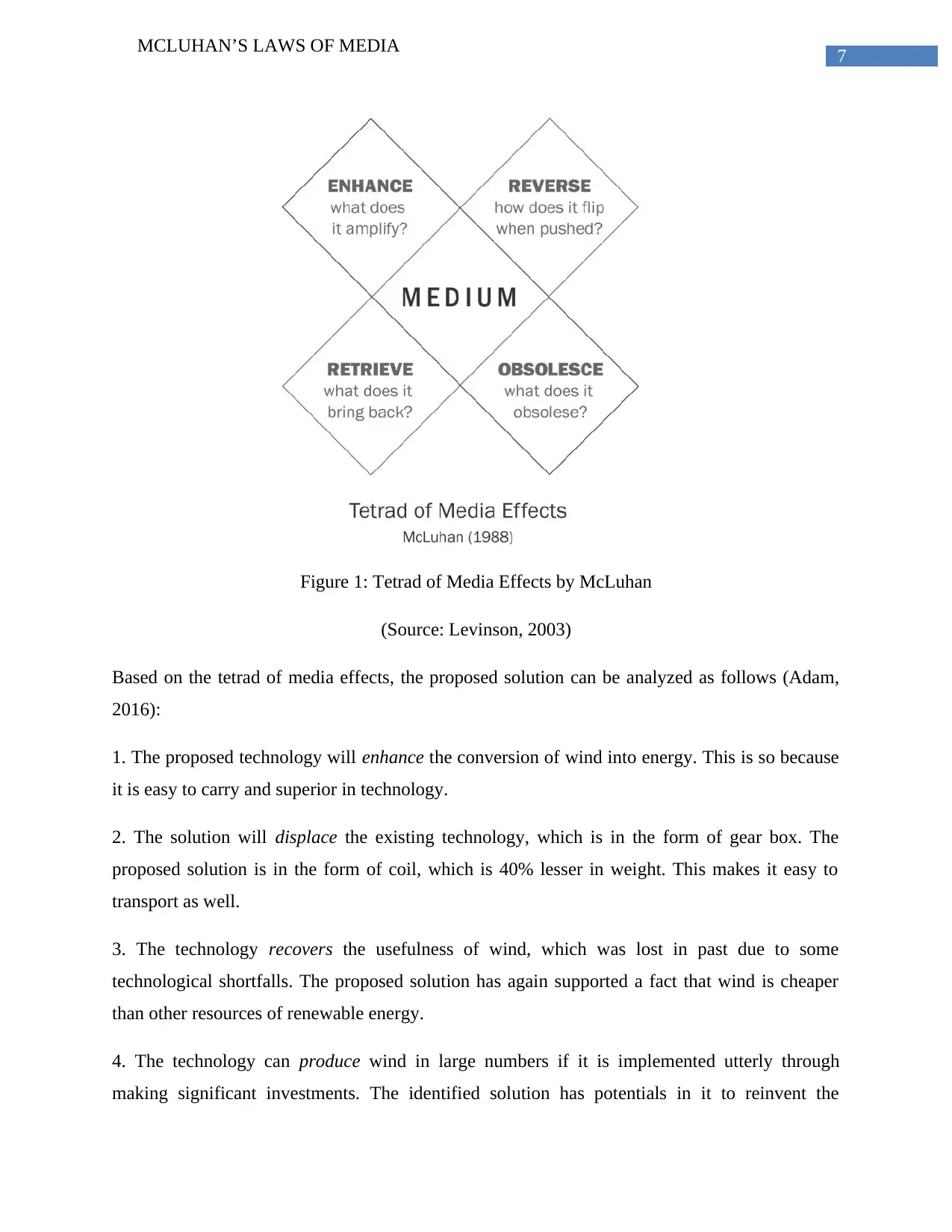
7
MCLUHAN’S LAWS OF MEDIA
Figure 1: Tetrad of Media Effects by McLuhan
(Source: Levinson, 2003)
Based on the tetrad of media effects, the proposed solution can be analyzed as follows (Adam,
2016):
1. The proposed technology will enhance the conversion of wind into energy. This is so because
it is easy to carry and superior in technology.
2. The solution will displace the existing technology, which is in the form of gear box. The
proposed solution is in the form of coil, which is 40% lesser in weight. This makes it easy to
transport as well.
3. The technology recovers the usefulness of wind, which was lost in past due to some
technological shortfalls. The proposed solution has again supported a fact that wind is cheaper
than other resources of renewable energy.
4. The technology can produce wind in large numbers if it is implemented utterly through
making significant investments. The identified solution has potentials in it to reinvent the
MCLUHAN’S LAWS OF MEDIA
Figure 1: Tetrad of Media Effects by McLuhan
(Source: Levinson, 2003)
Based on the tetrad of media effects, the proposed solution can be analyzed as follows (Adam,
2016):
1. The proposed technology will enhance the conversion of wind into energy. This is so because
it is easy to carry and superior in technology.
2. The solution will displace the existing technology, which is in the form of gear box. The
proposed solution is in the form of coil, which is 40% lesser in weight. This makes it easy to
transport as well.
3. The technology recovers the usefulness of wind, which was lost in past due to some
technological shortfalls. The proposed solution has again supported a fact that wind is cheaper
than other resources of renewable energy.
4. The technology can produce wind in large numbers if it is implemented utterly through
making significant investments. The identified solution has potentials in it to reinvent the
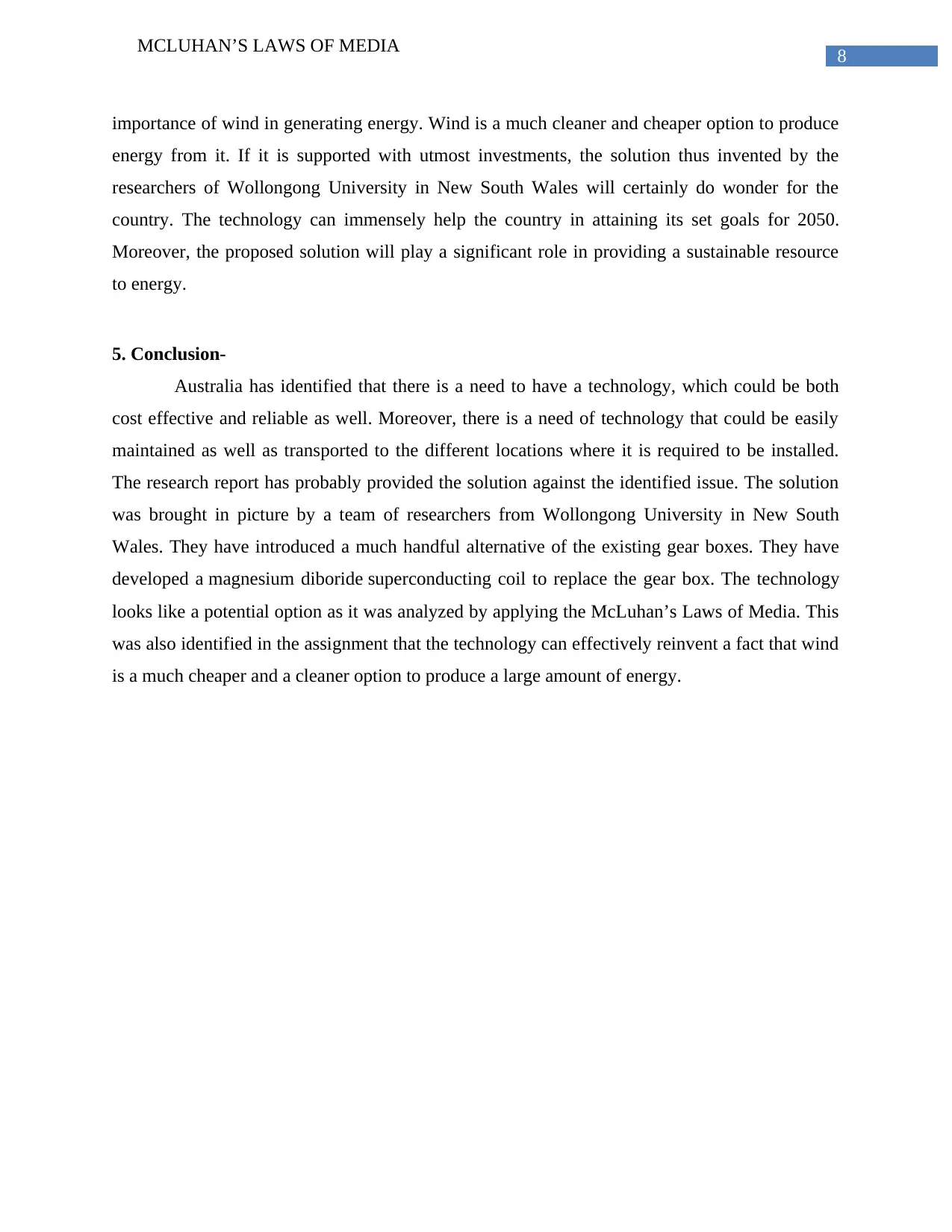
8
MCLUHAN’S LAWS OF MEDIA
importance of wind in generating energy. Wind is a much cleaner and cheaper option to produce
energy from it. If it is supported with utmost investments, the solution thus invented by the
researchers of Wollongong University in New South Wales will certainly do wonder for the
country. The technology can immensely help the country in attaining its set goals for 2050.
Moreover, the proposed solution will play a significant role in providing a sustainable resource
to energy.
5. Conclusion-
Australia has identified that there is a need to have a technology, which could be both
cost effective and reliable as well. Moreover, there is a need of technology that could be easily
maintained as well as transported to the different locations where it is required to be installed.
The research report has probably provided the solution against the identified issue. The solution
was brought in picture by a team of researchers from Wollongong University in New South
Wales. They have introduced a much handful alternative of the existing gear boxes. They have
developed a magnesium diboride superconducting coil to replace the gear box. The technology
looks like a potential option as it was analyzed by applying the McLuhan’s Laws of Media. This
was also identified in the assignment that the technology can effectively reinvent a fact that wind
is a much cheaper and a cleaner option to produce a large amount of energy.
MCLUHAN’S LAWS OF MEDIA
importance of wind in generating energy. Wind is a much cleaner and cheaper option to produce
energy from it. If it is supported with utmost investments, the solution thus invented by the
researchers of Wollongong University in New South Wales will certainly do wonder for the
country. The technology can immensely help the country in attaining its set goals for 2050.
Moreover, the proposed solution will play a significant role in providing a sustainable resource
to energy.
5. Conclusion-
Australia has identified that there is a need to have a technology, which could be both
cost effective and reliable as well. Moreover, there is a need of technology that could be easily
maintained as well as transported to the different locations where it is required to be installed.
The research report has probably provided the solution against the identified issue. The solution
was brought in picture by a team of researchers from Wollongong University in New South
Wales. They have introduced a much handful alternative of the existing gear boxes. They have
developed a magnesium diboride superconducting coil to replace the gear box. The technology
looks like a potential option as it was analyzed by applying the McLuhan’s Laws of Media. This
was also identified in the assignment that the technology can effectively reinvent a fact that wind
is a much cheaper and a cleaner option to produce a large amount of energy.
⊘ This is a preview!⊘
Do you want full access?
Subscribe today to unlock all pages.

Trusted by 1+ million students worldwide
1 out of 9
Your All-in-One AI-Powered Toolkit for Academic Success.
+13062052269
info@desklib.com
Available 24*7 on WhatsApp / Email
![[object Object]](/_next/static/media/star-bottom.7253800d.svg)
Unlock your academic potential
Copyright © 2020–2025 A2Z Services. All Rights Reserved. Developed and managed by ZUCOL.
